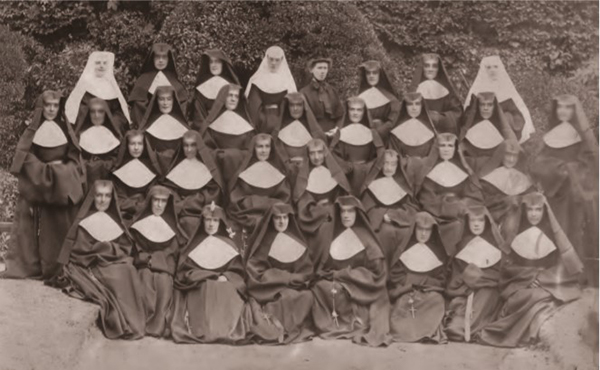Small lives: at home in Cork in 1920
Published in Issue 1 (January/February 2021), News, Volume 29Nano Nagle Place, Douglas Street, Cork
By Danielle O’Donovan
The inspiration for this exhibition came from women’s words recorded in the Bureau of Military History (BMH) and the South Presentation Convent annals. Through the written records of the Presentation Sisters and their pupils, could we discover their impact on the world, and the world that existed outside the convent walls in Cork in 1920?
In her BMH statement of May 1948 Mary Perolz describes how at the age of eleven in 1886 she went to Cork and attended the Presentation Convent, where ‘it was the Presentation nuns who made a rebel of me, Sister Bonaventure especially’. Perolz was involved in almost every nationalist and radical movement for the next 30 years, from the Gaelic League to Inghinidhe na hÉireann, and from Cumann na mBan to the Citizen Army. In the years after 1916 she was a key figure in reviving the Irish Women Workers’ Union and worked for the rights of women and children for the rest of her life.
Who was Sr Bonaventure and whence came this rebellious spirit? Often the lives of individual Presentation Sisters can be hard to trace through convent records. Committing themselves to a life of humility, many sisters are recorded only by a few lines of obituary in the convent annals. Not so Bonaventure Kennedy, who was born in Killenaule, Co. Tipperary, in 1861. In her 62 years of religious life she established the secondary school at South Pres, sending her graduates into professional and academic life. Her obituary appeared in the Cork Examiner in 1944, where Sir Bertram Wilde, president of UCC, referred to her as a ‘truly remarkable woman’.

Above: The Cork South Presentation Convent community in 1909. Sr Bonaventure Kennedy—‘a truly remarkable woman’—is seated in the front row, fourth from right; Sr Michael O’Brien, a first cousin of Michael Collins, is standing in the third row, fourth from right. (Presentation Sisters Congressional Archives)
Woven into the testimonies of the BMH statements is another mention of a sister of the South Presentation Convent, Sr Michael O’Brien, who in her brief obituary in the convent annals is described as principal of the junior school for many years. Sr Michael, who had been born Josephine O’Brien in Ardfield, West Cork, in 1876, was a first cousin of Michael Collins on his mother’s side. According to the BMH, she received a letter from a missionary priest, Fr Ignatius, who had heard Collins’s confession just before he departed to negotiate the Treaty. The letter makes clear that Fr Ignatius was answering a question about Collins’s spiritual well-being, and the priest was reassuring:
‘Sister, I haven’t the slightest fear for Michael’s salvation. Michael is in Eternal Joy. His hidden self was the most glorious part of him. Others may think of him as the great big and brainy Hero, but … the sweetest truth and thought of all—“Michael Collins was a Saint”.’
The convent annals are a rich source of information on convent life but mention of events outside is rare, as might be expected from those living in enclosure. But 1920 was an exception:
‘Guerilla warfare is raging between some of our poor countrymen and auxiliary troops sent over by the English Government. Many are the outrages committed on both sides and many innocent people have lost their lives. Even we are living in terror of what is going on around us; explosions in or near the city, and night is almost hell-like from the firing of machine and other guns and from burnings, as when the troops tried to fire the city. But God has wonderfully protected us and we have suffered nothing worse than fright. Deo Gratias.’
Other documents held in our archives cast light on life outside the convent, particularly the school registers, which record the names, addresses and ages of the children, along with the occupations of their fathers. They remind us that, despite the Presentation Order being enclosed, the children they educated brought the life of the city through the school doors every day. Between South Pres, North Pres and the South Mon, over 700 children were newly registered to attend Presentation schools across the city in 1920.
These children lived in tenements and tiny cottages, in RIC barracks and above shops. Their fathers were casual labourers, tradesmen and professionals. Some fathers are recorded as soldiers, and many more are recorded as dead. Although many were likely the victims of disease and accidents, some must have been numbered amongst the 4,200 men from Cork, city and county, who were killed during the First World War.
One question we could not answer about the ‘small lives’ attending the Presentation schools of Cork was how many parents were members of Cumann na mBan and the Irish Volunteers. And, in the playground, what was it like for the children of republican parents to play hopscotch with the children of RIC men?
The exhibition runs until the end of March 2021.
Danielle O’Donovan is the Programme Manager at Nano Nagle Place and an occasional lecturer and tutor in the history of art at UCC and Cork Centre for Architectural Education.


















